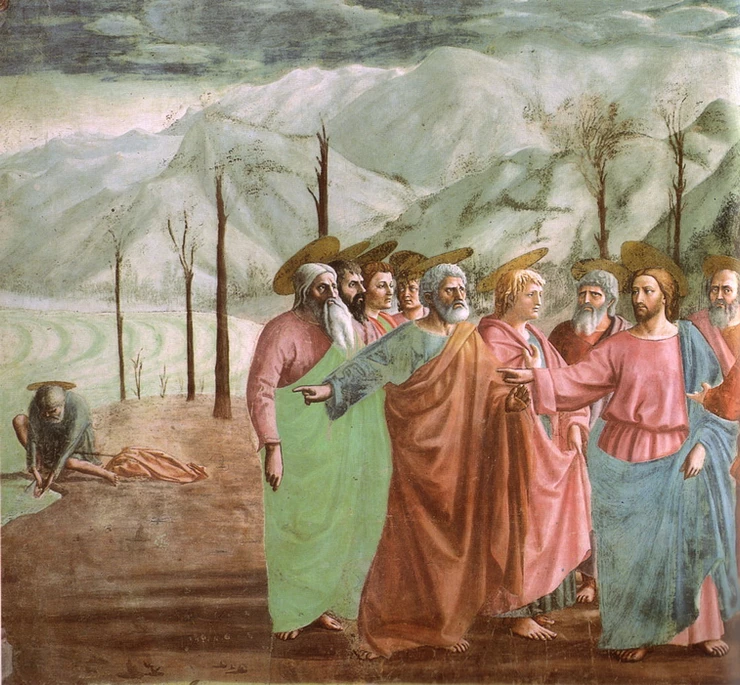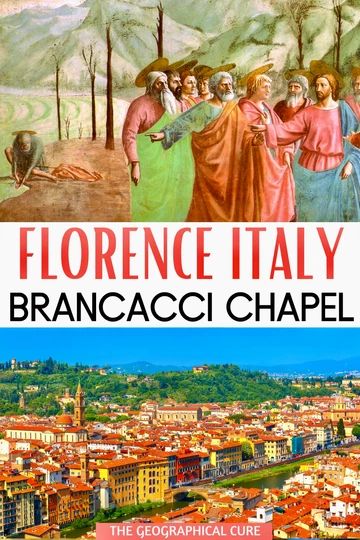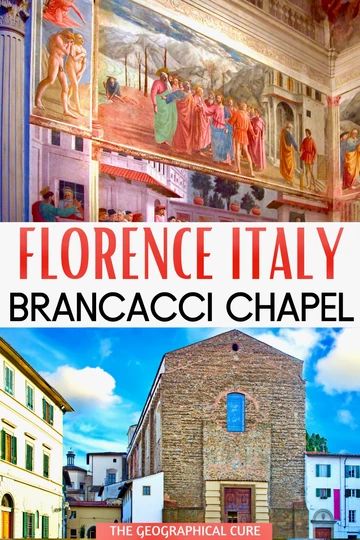Looking to explore some of the finest art in Florence, Italy? Look no further than the Brancacci Chapel. With a stunning fresco cycle painted by the artist Masaccio, this attraction is a must see for art lovers.
Masaccio’s frescos in the Brancacci Chapel are a paramount work in art history, marking a key turning point from the International Gothic style to the Early Renaissance.
As the most influential decorative space of the 15th century, the chapel has earned the nickname “Sistine Chapel of the Early Renaissance.” It’s considered one of Italy’s most beautiful chapels.
In this guide, we’ll explore everything you need to know about visiting the Brancacci Chapel, from its fascinating history to the best ways to experience its awe-inspiring frescos.
Surprisingly, many tourists tend to skip this masterpiece when visiting Florence. One reason for this is the chapel’s location, which is slightly off-center in the Oltrarno neighborhood, on the other side of the Arno River.
Additionally, admission is limited to only 30 people at a time. Visitors need to make a timed entry reservation in advance. But it’s well worth the effort. You can book a ticket here or book a guided tour in English.
The chapel is currently under restoration for all of 2023. But you can still visit, admire the works, and even get a close up view by climbing the scaffolding.
Who Was Masaccio?
The artist Masaccio was a Renaissance wunderkind. Though his life went by in a flash, he was a hugely innovative painter. Masaccio had radical ideas about what could be done with a flat painted surface. They seemed to come out of nowhere.
These radical ideas helped shape the history of Western art. Some art historians call Masaccio the first truly Renaissance artist.
He was the first painter in art history to experiment with linear point perspective. Masaccio adapted the techniques of the architect Brunelleschi, a pioneer of perspective theory. It gave his paintings the illusion of depth.
Second, Masaccio depicted believable people in believable spaces. His figures were lifelike creatures of flesh and blood.
They were starkly different than the stylized, sometimes zombie-like figures, from the medieval period. Taking a cue from Giotto, Masaccio’s characters are dramatic, touching, emotive, and volumetric. Sometimes he portrayed the harsh reality of the real world in all its imperfection.
History Of The Brancacci Chapel
The Brancacci Chapel is located in the Church of Santa Maria del Carmine. The church is the seat of the Carmelite Order.
Construction of the church began in 1268. It dragged on for nearly two centuries. It wasn’t completed until 1475. The building of the chapel was commissioned by Piero Brancacci.
But it wasn’t until 1424 that Felice Brancacci commissioned Masaccio’s frescos. He was a wealthy silk merchant, flush with money from a prosperous business.
He was an avowed enemy of the ruling Medici family. Brancacci wanted to create something to rival the Medici Palaces in Florence.
The frescos were intended to depict the life of St. Peter, from original sin to the salvation of man. There was a special focus on healing and redemption for the poor.
Brancacci hired Masolino (40) and his pupil Masaccio (22) to decorate the chapel. Masolino painted a few scenes and then left for Budapest. A young Masaccio kept painting, creating one of the greatest Early Renaissance fresco cycle.
You can easily tell the difference between the two artists. Masolino’s paintings are stiff and “Barbie doll-ish.” Masaccio’s paintings burst with emotion and naturalism.
Masaccio left for Rome in 1428. There, he died abruptly, most likely of malaria, at age 27. The frescos were then abandoned for almost 60 years.
Between 1481-85, the fresco cycle was completed by Filippino Lippi. Filippino was the son of another renowned painter, Fra Filippo Lippi. He was in the workshop of the great painter Botticelli.
Thereafter, the Brancacci Chapel became a sort of school for Renaissance artists. The Florentine artist and art historian Giorgio Vasari claimed that “all the most celebrated painters and sculptors came” with sketchbook in hand to learn about single point perspective and how to paint the human body.
The great Michelangelo was among them. The Masaccio frescos were a tremendous influence on Michelangelo’s frescos in the Sistine Chapel in the Vatican Museums.
Leonardo da Vinci arrived as well. He called Masaccio’s frescos “perfect.”
Masaccio’s frescos survived a great fire in 1771 that destroyed much of the Carmine. In 1980, the frescos were cleaned and restored to remove centuries of grime. The restoration revealed their original vivid colors.
In 2021, Florence announced that another three year restoration was forthcoming. This one is intended to stabilize the frescos. The restoration began in February 2022 and will continue throughout 2023.
Guide To The Brancacci Fresco Cycle
Let’s step into the birthplace of Renaissance painting! You read the Brancacci frescos left to right, top to bottom. They’re in roughly chronological order.
The frescos and their respective artists are:
- • Temptation (Masolino)
- • Expulsion From Paradise (Masaccio)
- • Tribute Money (Masaccio)
- Healing of the Cripple and Raising of Tabitha (Masolino)
- St Peter Preaching (Masolino)
- Baptism of the Neophytes (Masaccio)
- St. Peter Healing the Sick With His Shadow (Masaccio)
- Distribution of Alms and Death of Ananias (Masaccio)
- Raising of the Son of Theophilus and St. Peter Enthroned (Masaccio and Filippino Lippi)
- Disputation with Simon Magus and Crucifixion of St Peter (Filippino Lippi)
- St Paul Visiting St Peter in Prison (Filippino Lippi)
- Peter Being Freed from Prison (Filippino Lippi)
I focus on the Masaccio pieces and one Lippi fresco, which are the top masterpieces in the chapel.
1. Masaccio, The Tribute Money
In the upper registry, there’s one of Masaccio’s greatest masterpieces, The Tribute Money. This fresco is regarded as the most important work of art in the chapel.
The Tribute Money tells the story of a Roman tax collector in Capernaum. It portrays three different moments in time in a single panel. This was a common technique in the early Renaissance.
The narrative in Tribute Money starts at the center, moves to the far left, and concludes at the far right. The only figure who is represented in all three sections is Peter.
The frescos depict a story from the New Testament. Christ is confronted by a tax collector. Will he pay?
Christ orders Peter to get a fish from the lake. Then Christ performs a miracle, saving the day. He causes money to appear in the mouth of a fish. Christ then settles the debt.
Everything about the fresco screams Renaissance. There’s a use of linear perspective. The vanishing point is located at the head of Christ. The drapery is sculptural, reflecting the influence of the sculptor Donatello. Even the halos are in perspective.
A quality mountainscape is in the background. It’s reduced to the bare essentials, producing a dramatic effect.
Masaccio also focused on the faces of the witnesses. No two faces look the same. Their expressions have varying degrees of suspicion and astonishment.
The gatekeeper in the right foreground has bare legs and orange frock. His left hand reaches forward in a remarkable use of foreshortening perspective.
2. Masaccio, Expulsion from Paradise
Just to the left of The Tribute Money is another must see Masaccio masterpiece, the Expulsion of Adam and Eve From Eden. It’s one of the most powerful paintings in the history of art.
In this fresco, a red-clad armed angel banishes Adam and Eve from Paradise. It’s an emotional painting. The anatomy of Adam and Eve is realistic and detailed.
Adam wails and appears distraught. He’s engulfed in grief. He seem to be almost physically heaving in shame and distress.
Eve cries and tries to cover herself. You can see her breasts compressed against her chest. Eve’s face is an expressive mask of horror. Her face is almost akin to Edvard Munch’s most famous painting The Scream.
The fresco is on a tall pictorial field. It was the first depiction of a naked human body that was similar to statues from antiquity.
Masaccio also used shadow and a light-dark contrast for the first time. This is known as chiaroscuro. You can see the bodies of Adam and Eve casting shadows. They are lit from an illusionist window.
Interestingly, Adam’s private parts were painted over with fig leafs by order of the ultra religious Cosimo III de’ Medici in 1642. This was during the conservative backlash of the Counter Reformation period.
A similar disfiguring was doled out to Michelangelo’s Last Judgment in the Sistine Chapel. During restoration, the figure of Christ was returned to the original nude.
The other tall image of Adam and Eve, Temptation, is by Masolino. It depicts the pair engaged in the big “sin” of eating a fig.
The Masaccio and Masolino Adams and Eves couldn’t be more different. Masolino’s figures look much more artificial and stylized than Masaccio’s. Their faces are blank and unlined. They float in space.
3. Masaccio, Baptism of the Neophytes
This picture shows Peter baptizing people into the church. Peter is depicted naturally.
His right foot is firmly on the ground and his left foot is slightly raised. He’s balancing in contrapposto as he does his baptizing.
The halo is in perspective above Peter’s head. You can see the muscular development of the neophyte being baptized. You can even see his wet dripping locks. No artist had painted wet hair before.
Look to the far right of the baptism scene. A nearly naked man stands in the lake with his arms crossed. He looks off in the distance. It’s a convincing image of a man who looks like he’s freezing to death.
4. Masaccio, St. Peter Healing the Sick With His Shadow
In this painting, you see a captivating depiction of Peter. Legend holds that he was so holy that even his shadow could heal people.
This subject was a rare image at the time. Shadows had just entered the artist’s repertoire.
One startling feature of the painting is the detail of the cityscape. The street is lined with medieval Florentine houses. The stone looks similar to that found on the Palazzo Vecchio.
St. Peter doesn’t look at the viewer as he strolls down the streets. With a serious face, he also walks past the crowds without noticing them. This underscores the miracle that his shadow does all the work.
The beggar in the lower left is portrayed in stark brutal reality. He has hand crutches and disfigured legs. That’s what the new naturalism of the early Renaissance was about. It was seen as shocking at the time.
The figure in the blue tunic praying is a portrait of the sculptor Donatello.
5. Masaccio, Distribution of Alms and Death of Ananias
In this picture, Peter is distributing alms. At the time, people pooled their resources and redistributed them according to need. Yes, they were communists.
In the painting, you see the wealthy Ananias. Peter strikes him dead when he doesn’t cough up his fair share.
The painting is somewhat damaged. But there are a few good details that reveal Masaccio’s painting skill.
There’s a diaperless child held by his or her mother. The buttocks are revealed. Again, this is an element of naturalism that didn’t exist before Masaccio.
Another hint of naturalism is the woman on the far left in a white hood. Her skin has a leathery quality. It’s mesmerizingly realm.
6. Masaccio & Lippi, Raising of the Son of Theophilus and St. Peter Enthroned
Down to the lower register, you find this painting. The story goes that after Christ died, Peter began traveling around converting people to Christianity
Peter was eventually imprisoned for proselytizing. But the king wanted help to resurrect his son from the dead.
Peter performed the miracle and was thereafter venerated. You can see him being honored in another scene on the far right side of the fresco.
Theophilus is on the throne in pink. Peter extends his hand to the young son, who is naked. The figures are densely crowded int eh central scene.
The most distinctive feature about this painting is the way Masaccio arranges the figures in an S-shape around the two Peters.
Both Masaccio and Lippi painted this fresco. Lippi painted the five figures on the far left and a few figures in the central scene to the right of the boy being baptized. On the right, the figure looking out at us (with the rather large nose) is a self portrait of Masaccio.
7. Lippi, The Crucifixion of Saint Peter and the Dispute with Simon Magus
This fresco depicts the last two episodes from the story of the Peter’s life. To the right, we see him disputing Simon Magus in front of the Emperor. Simon has trying to buy his way into the powers of the apostles. To the left, we see Peter’s crucifixion.
According to the Golden Legend, Peter refused to be crucified in the same way as Christ because he felt unworthy.
He was therefore allegedly crucified in an inverted position, which you can see in the bottom left corner of the painting. This place of crucifixion became the the location chosen for the St. Peter’s Basilica in Rome.
Lippi also includes a self portrait in the fresco. The painter stares back at us, as if to communicate through time.
Practical Guide & Tips For The Brancacci Chapel
Here are some key tips and things to know to visit the Brancacci Chapel:
Address: Piazza del Carmine 14. To get there, cross the Arno at Ponte alla Carraia. The chapel is an approximately 15 minute walk from the Uffizi Gallery.
Entrance: Access to the Brancacci Chapel is from the entrance that leads to the cloister of Santa Maria del Carmine. You can’t enter the chapel from the church.
Access: Only 30 people can access the chapel at one for a 30 minute visit.
Hours: Monday and Wednesday-Saturday 10:00 am to 5:00 pm, Sunday 1:00 pm to 5:00 pm. Closed Tuesdsays.

Entry fee: The church itself is free. The chapel is 10 euros. You need to book online and make an advance reservation to visit the chapel.
I hope you’ve enjoyed my guide to the Brancacci Chapel in Florence. You may enjoy these other Florence travel guides and resources:
- 1 day itinerary for Florence
- 2 day itinerary for Florence
- 3 Day Itinerary for Florence
- Best Museums in Florence
- Hidden Gems in Florence
- Florence art bucket list
- How To See Michelangelo’s David
- Guide to the Medici Chapels
- Must See Sites in Florence
- Statues of the Piazza della Signoria
- Florence’s Duomo and Brunelleschi’s Dome
If you’d like to visit the Brancacci Chapel in Florence, pin it for later.


